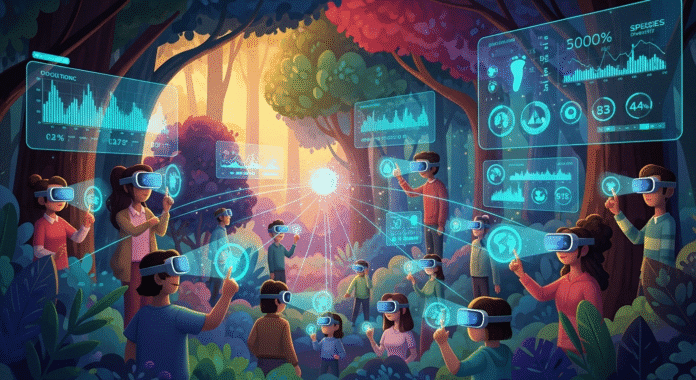Harnessing Empathy and Inclusive Technology for Environmental Transformation
Wendy Schmidt believes that science and immersive media are not only catalysts for innovation but also powerful tools to inspire real-world action. By combining extended reality experiences with inclusive AI programming, she envisions a future where technology bridges divides and motivates individuals to care for the planet. Schmidt’s initiatives, such as Agog: The Immersive Media Institute, aim to transform abstract global challenges into personal, relatable experiences, thereby fostering empathy and igniting the collective will for change.
Innovative Tools for Global Change
Agog: Rewriting the Narrative Through Immersive Media
Agog: The Immersive Media Institute is one of Wendy Schmidt’s boldest initiatives. This new platform uses virtual, augmented, and mixed reality to create experiences that let users “walk in someone else’s shoes.” The idea is simple yet profound: when people see environmental challenges as vivid, tangible problems—whether through a deep-sea expedition broadcast or an augmented exploration of nature—they are more likely to take action. As Schmidt remarks,
“Empathy is the first step toward action. When people see and feel the world’s challenges, they are more likely to help solve them.”
This immersive approach transforms distant and often abstract issues, like ocean acidification or deforestation, into experiences that resonate on a human level.
Creating Empathy Through Extended Reality
Extended reality (XR) has evolved from a futuristic concept to a practical tool for storytelling. By simulating real-world environmental scenarios, XR bridges the gap between scientific data and emotional understanding. Experiences developed under Agog have already demonstrated that when users engage with realistic representations of climate change or biodiversity loss, they often commit to more sustainable practices in their daily lives. This ability to foster empathy through technological innovation is proving to be a game changer for environmental action.
Inclusivity in AI and the Science of Change
Programming for Everyone
Central to Schmidt’s approach is the belief that technology must work for everyone. Inclusive AI involves integrating diverse perspectives, especially those of traditionally marginalized communities, into tech development. Schmidt argues that including Indigenous wisdom and local knowledge enhances the relevance and impact of technological solutions. When AI and XR applications incorporate varied cultural insights, they become more responsive to the needs of different populations, ensuring that the benefits of innovation are shared broadly.
Merging Traditional Wisdom with Modern Technology
Schmidt is cautious not to repeat the missteps of past innovations. While early digital platforms sometimes intensified societal divides, her vision emphasizes balance and responsibility. By merging traditional wisdom with cutting-edge science, her initiatives are setting a high standard for ethical innovation. This commitment is evident in the design of Agog projects, where community input guides the development process, ensuring that the resulting technology reflects a collective vision for a sustainable future.
Challenges and Opportunities
Overcoming Funding Obstacles to Foster Innovation
A significant challenge in the realm of environmental and technological innovation is the loss of funding for vital projects. Many promising initiatives have struggled to find sustained financial support. Wendy Schmidt, through her philanthropic efforts, has stepped in to back scientists and researchers in their quest to save the planet. By funneling resources toward critical areas—such as deep-ocean research, renewable energy, and immersive media projects—she not only fills a funding gap but also inspires others in the public and private sectors to contribute.
Balancing Innovation With Caution
Critics of rapid technological advancement worry that extended reality and AI could inadvertently widen social inequalities or be misused. Schmidt acknowledges these valid concerns and champions the development of robust ethical frameworks. Careful regulatory oversight, combined with community-driven design, is essential to ensure that these tools promote unity rather than division. This balanced approach is not about stifling innovation but rather about guiding it so that the progress benefits every segment of society.
The Transformative Potential for Human Civilization
Building a More Connected and Resilient Global Community
Imagine a world where every person feels a direct connection to the planet instead of viewing environmental issues as distant, abstract problems. Immersive media can create that bridge by transforming scientific data into vivid, relatable stories. When citizens witness the melting glaciers or dying coral reefs in a virtual environment, the emotional impact can drive them to support policy changes, adjust behaviors, or participate in community initiatives. Such collective action is essential for tackling systemic challenges like climate change and biodiversity loss.
Inspiring Behavioral Shifts for a Sustainable Future
Behavioral change is at the heart of Schmidt’s vision. By using immersive media to show the direct consequences of actions on the environment, individuals are more likely to adopt sustainable lifestyles. This is supported by cases where communities engaged in XR experiences reported increased efforts to recycle, use renewable energy, and conserve water. The ripple effects extend beyond individual actions; they create a groundswell of public support for progressive environmental policies and innovations in green technology.
Emphasizing the Role of Collaborative Philanthropy
Schmidt’s work highlights a collaborative approach to philanthropy, where supporting science and technology goes hand in hand with fostering community resilience. Her efforts remind us that solving global issues requires a willful collective commitment. When philanthropists, industry leaders, and community organizations work together, the potential for groundbreaking change is immense. This collaborative spirit is a cornerstone of her philosophy and a call for society to embrace innovative, inclusive technologies as a fundamental part of building a better future.
Looking Ahead: A Call to Action
The Urgency of Embracing Innovation for Planetary Survival
Wendy Schmidt’s visionary perspective teaches us that the path to a sustainable future is paved with empathy, ethical innovation, and collective responsibility. Her insistence that immersive media and inclusive AI can foster global unity sets a powerful example. In a time when the challenges of climate change and social inequity loom large, her message is clear: technological innovation must serve humanity and the natural world. It is now up to governments, businesses, and individuals to heed this call and work together for a resilient planet.
A Rallying Cry for Every Citizen
The time to act is now. Whether you are a scientist, policymaker, or simply a concerned citizen, there is a role for everyone in this transformative journey. Engage with new immersive experiences, support inclusive tech initiatives, and advocate for policies that prioritize sustainability and social equity. As Wendy Schmidt reminds us through her work,
“We have the creativity and resilience as a species to make these changes; it’s crucial for our survival.”
Let this inspiration drive us to build the future we all deserve.
Join the Movement for a Sustainable Future
Wendy Schmidt’s pioneering work offers a comprehensive blueprint for leveraging science, immersive media, and inclusive AI to propel the world toward a more just and sustainable future. By transforming complex environmental challenges into relatable experiences, she inspires empathy and empowers communities to take meaningful action. Now is the time for stakeholders across society to collaborate, innovate, and invest in these transformative technologies. Join this movement by embracing these new tools and ideas—let us work together to secure a future where technology and nature thrive in harmony.




